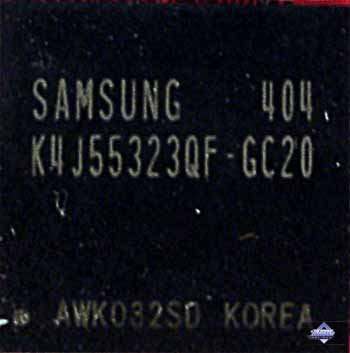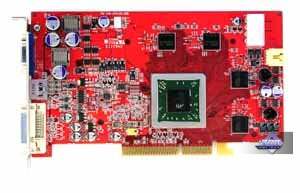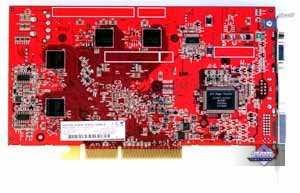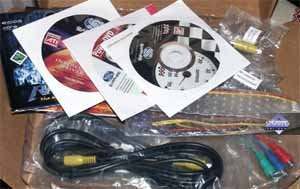Battle of
ATI RADEON X800 XT and NVIDIA GeForce 6800 Ultra
- Part Four:
RightMark3D-based Filtering Tests
Sapphire RADEON X800 Pro Review
|

CONTENTS
- Introduction
- Part 1: Features of R420/NV40
videocards
- Part 1: Configurations
of testbeds, test tools
- Part 1: Quality: Bilinear
filtering
- Part 1: Quality: Trilinear
filtering
- Part 1: Quality: Anisotropic
filtering
- Part 2: Sapphire Atlantis
RADEON X800 Pro features
- Part 2: Performance
- Conclusions
Part 2: Sapphire Atlantis RADEON X800 Pro features
| Sapphire Atlantis RADEON X800 Pro |

|
|
Sapphire Atlantis RADEON X800 Pro
|
|
AGP x8/x4 interface, 256 MB GDDR3 SDRAM
allocated in eight chips on the front and the back sides of the PCB.
Samsung memory chips (GDDR3), 2.0ns access time which corresponds to
500 (1000) MHz; memory frequency is 450 (900) MHz, GPU frequency is 475 MHz, memory bus is 256 bits.
|

|
| Comparison with the reference design,
front view |
|
Sapphire Atlantis RADEON X800 Pro
|
Reference card ATI RADEON X800 PRO
|

|

|
| Comparison with the reference design,
back view |
|
Sapphire Atlantis RADEON X800 Pro
|
Reference card ATI RADEON X800 PRO
|

|

|
We don't see any sense in a further description of the card, as it is the
same reference design. And besides,
all X800 boards are produced only in one place and only by ATI orders,
vendors just apply their stickers.
Let us look at the bundle instead.
|
Sapphire Atlantis RADEON X800 Pro
|
|
It includes a user manual, a CD with drivers, a CD with a proprietary RedLine utility, PowerDVD, game Tomb Raider: Angel of
Darkness, TV extension cords, adapters: DVI-to-d-Sub, HDTV, and SVideo-to-RCA. The package will soon be enlarged with games Splinter Cell: Pandora Tomorrow and Hitman: Contracts.
|

|
And this is the box:
As for overclocking, this particular card showed stable work at 540/1180 MHz providing the presence of an additional fan. But we repeat that overclocking depends on each particular card and you can't make general conclusions basing on just one of them.
Test results: Performance
These are the tools we used:
- Unreal 2: The Awakening (Infogrames), DirectX 8.1, multitexturing, testing is carried out with an auxiliary
Bench'emAll! 2.5beta pack.
- RightMark 3D (one of the game scenes): DirectX 8.1,
Dot3, cube texturing, shadow buffers, vertex and pixel shaders (1.1, 1.4).
Test settings: pixel shaders 1.1, shadow buffers OFF.
- Half-Life2 (Valve/Sierra): DirectX 9.0, two different
demos (ixbt07 and coast).
Testing was carried out with anisotropic filtering enabled.
- Tom Clancy's Splinter Cell v.1.2b (UbiSoft): Direct3D, Vertex/Pixel Shaders 1.1/2.0, Hardware T&L, maximal quality (Very High); demo 1_1_2_Tbilisi. AntiAliasing doesn't work in the game.
- Call of Duty (MultiPlayer) (Infinity Ward/Activision): OpenGL, multitexturing, ixbt0104demo, test settings are all maximal, S3TC ON
- Tomb Raider: Angel of Darkness v.49 (Core Design/Eldos Software): DirectX 9.0, Paris5_4 demo, test settings are here.
- Fac Cry v.1.1 (Crytek/UbiSoft), DirectX 9.0, multitexturing,
demo01 (startup with the -DEVMODE option), all test settings are Very High.
Those willing to get the demo benchmarks we use, please contact me by e-mail.
Performance
- 1. Call of Duty
- 2. FarCry
- 3. Unreal 2: The Awakening
- 4. Tomb Raider: The Angel of Darkness
- 5. RightMark 3D
- 6. Half Life 2 beta
Conclusions
First, the analysis of Sapphire Atlantis RADEON X800 Pro.
The tests show that today, products of this class are the most powerful ones and unachievable to rivals, considering the absence of GeForce 6800 (of all kinds) and RADEON X800 XT. We can also see that if the prices for X800 Pro and GeForce 6800 GT remain the same as was announced in May ($399), then the latter will have a certain advantage. However, X800 Pro is likely to go down to $299 in a short time, thus freeing the niche for X800 XT (not a Platinum
Edition one) which only differs from PE in lower frequencies. Then the situation will become more favourable for ATI. But if the prices remain the same as they are now
(about USD 480-500 for X800 Pro), the same-priced 6800 GT will be more attractive in spite of its lower frequencies (350 MHz) as it is a 16-pipeline chip.
As for the card itself, I have already mentioned that all X800's will be identical for a certain time and we can't speak about any distinctive features of this or that vendor. The bundle is very good and the package looks quite snappy (the same with 9800XT). Although a product that expensive might have been supplied in a more original box with a wider range of items (souvenirs and the likes).
Luckily, they promise to include new games into the package.
Now for RightMark3D tests.
First of all, we'd like to draw ATI's attention to the drivers that act illogically and harmfully for image quality when anisotropy is forced in driver settings along with applications that manage anisotropy themselves. This situation must seem familiar to ordinary users as powerful accelerators make them keep anisotropic filtering forced in driver settings. Something definitely has to be done about it. Although Alexey Barkovoy notes that it is all about the control panel, the shortcoming seems to have been travelling through versions for quite a while.
Second, a 16x quality is enough even for complex cases (such as our zebro-like texture) and further increase in the degree of anisotropy doesn't seem a top priority for us. Future products and drivers would be better off with a higher anisotropic quality in optimised modes as well as with a wider "fair" trilinear area. Pity ATI doesn't allow to disable trilinear filtering optimisation.
ATI scores best at 0° (and also at 90°, 180°, and 270°). Angles of 45°, 135°, etc. show a parity, although an increasing degree of anisotropy brings a rising advantage to NVIDIA in non-optimised modes. In the case of angles not divisible by 45
(20°, 30°, etc.), NVIDIA shows a higher maximal anisotropic filtering quality than ATI. Note that this article dealt with neither the performance/quality ratio nor the theoretical aspects of anisotropic filtering.
You can see more detailed comparisons of various videocards in our 3DiGests.
07.05.2004
Write a comment below. No registration needed!
|
|
 |
|
|
|
